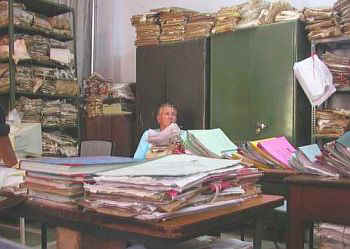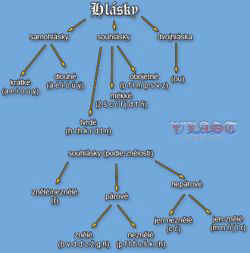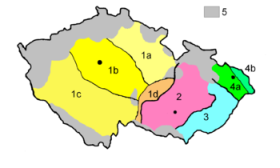Experience from a Czech to English Translations Translator
The Czech Republic was once part of the Austro-Hungarian Empire, which was notorious for its bureaucracy, argued as one reason why bureaucracy has become an integral part of the Czech mentality. This was further entrenched under half a century of Communist, central-management rule.  It was quite the struggle to set up shop when I first arrived here shortly after the switch to a free market, such that I joked one had to get a stamp on a paper in order to get another stamp on another paper before grabbing the third piece of paper in order to wipe one's own arse. Over the years procedures have slowly softened their corners, even though it had continued to be a painful process to watch. For example, in the beginning of the free enterprise translation business here in the Czech Republic, it was common that agencies would require the same number of words in the translated document as in the source Czech. Czech does not have articles such as 'a' or 'the', and for other reasons I generally find that a translation into English generally has about 20% more words than the source Czech document. Although this level of stringency has abated, still I occasionally come into conflict with Czech agencies or customers who complain that I had taken too many liberties converting their precious words into another language. They failed to realise that it is not their own words that our so precious but rather, from a marketing perspective at least, it is the perception of their target audience that is more important. After all, is not the purpose of most translation to sell something? Hence, the customer is king. It was quite the struggle to set up shop when I first arrived here shortly after the switch to a free market, such that I joked one had to get a stamp on a paper in order to get another stamp on another paper before grabbing the third piece of paper in order to wipe one's own arse. Over the years procedures have slowly softened their corners, even though it had continued to be a painful process to watch. For example, in the beginning of the free enterprise translation business here in the Czech Republic, it was common that agencies would require the same number of words in the translated document as in the source Czech. Czech does not have articles such as 'a' or 'the', and for other reasons I generally find that a translation into English generally has about 20% more words than the source Czech document. Although this level of stringency has abated, still I occasionally come into conflict with Czech agencies or customers who complain that I had taken too many liberties converting their precious words into another language. They failed to realise that it is not their own words that our so precious but rather, from a marketing perspective at least, it is the perception of their target audience that is more important. After all, is not the purpose of most translation to sell something? Hence, the customer is king.
Hence it has been a frustrating experience working for Czech customers, because Czechs can be proud and perfectionist, whereby they are convinced their perfect Czech presentation will sound equally perfect in another language if translated perfectly. Or closer to a word-for-word translation, which can be painfully catastrophic. The trick is to grasp the original concept and write it from absolute scratch. From the gut.
Some Facts Regarding the Czech Language
The earliest preserved written Czech is from the 13th century, mostly in
the form of hymns transcribed in Bohemia. The first books were printed in the 1470s, also
in Bohemia.
Official Czech grammar was first formed in 1533 by Benes Optat, Petr Gzel
and Vaclav Filomates, and the first systematic general grammar was formulated in 1603 by
Vavrinec Benedikti of Nudozer.
The Czech language always pronounces its stress on the first syllable of
every word.
 The Czech language has 4
genders (neuter, feminine and 2 masculine - animate, inanimate), 7 cases (Nominative,
Genitive, Dative, Accusative, Instrumental, Locative, Vocative) and 2 numbers –
whether the object of the word is “breathing” or “not breathing”. This
creates more combinations and permutations than any other language, making it a very
difficult language to master. Within a sentence the ending of almost every word changes
depending on what it refers to (an adjective referring to a word having a certain case and
gender would change according to the prescribed rules). Many Czechs find this level of
exactness and detailed interconnections between words “beautiful”. One advantage
is that it can make legal and legislative text more precise, requiring noticeably fewer words
than would the English language, for example. But it also requires an intelligent mind and
someone who has sufficiently mastered the language to formulate the sentence properly. The Czech language has 4
genders (neuter, feminine and 2 masculine - animate, inanimate), 7 cases (Nominative,
Genitive, Dative, Accusative, Instrumental, Locative, Vocative) and 2 numbers –
whether the object of the word is “breathing” or “not breathing”. This
creates more combinations and permutations than any other language, making it a very
difficult language to master. Within a sentence the ending of almost every word changes
depending on what it refers to (an adjective referring to a word having a certain case and
gender would change according to the prescribed rules). Many Czechs find this level of
exactness and detailed interconnections between words “beautiful”. One advantage
is that it can make legal and legislative text more precise, requiring noticeably fewer words
than would the English language, for example. But it also requires an intelligent mind and
someone who has sufficiently mastered the language to formulate the sentence properly.
99% of the Czech population is literate and they are very proud of their language. It is perhaps this accustomed diligence to detail that has slowed the industry's progress. Or if not the progress of the translation industry than progress of those who utilise its resources while presenting themselves more poorly on the foreign stage.
History of the Czech Language
The Czech language belongs to the western group of Slavic languages, along
with Slovak, Polish, Pomeranian, high and low Sorbian, and Polabian (now extinct). It is
also loosely related to the east and south Slavic language groups.
The Czech language diverged from the other Slavic languages between the
tenth and sixteenth centuries through several major sound changes. Closer to the sixteenth
century, the Czech language also lost the dual number and 2 Slavic past tenses, while the
multitude of declensions and significance of the verbal aspect increased.
 The Czech language is
comprised of four major dialects - Bohemian, Central Moravian, Eastern Moravian, and
Silesian. Standard written Czech is based on the Prague dialect, its colloquial form
referred to as Common Czech, which has its origins in Central Bohemia. While the Bohemian
dialects are more uniform due to the influence of Common Czech, the Silesian dialects are
most diverse and approach in similarity to the Polish language. The eastern Moravian
dialect is something between Czech and Slovak. The Czech language is
comprised of four major dialects - Bohemian, Central Moravian, Eastern Moravian, and
Silesian. Standard written Czech is based on the Prague dialect, its colloquial form
referred to as Common Czech, which has its origins in Central Bohemia. While the Bohemian
dialects are more uniform due to the influence of Common Czech, the Silesian dialects are
most diverse and approach in similarity to the Polish language. The eastern Moravian
dialect is something between Czech and Slovak.
Overall, the Czech language has several core influences, the strongest of
which are Old Church Slavonic, Latin and German.
The Written Language of Czech
Until the end of the 13th century, the Czech language was confined within
the limitations of the Latin alphabet when describing the various sounds not found in
Latin. One in particular is a tightly rolled r not present in any other language (not even
Slovakian) and which Czechs get a great kick out of when listening to foreigners attempting
to pronounce it. They often proudly declare that it is the toughest consonant to pronounce
in the world. As more complex texts appeared, a more complex writing system became evident
and digraphs and trigraphs were introduced as a means to represent sounds not
found in the Latin language. Around the fifteenth century Jan Hus, a
religious reformer, introduced a diacritical writing system, adding certain symbols above
selected characters (c, d, n, r, s, t, a, e, i, o, u, y) to depict the string of letters
formed from the digraphs and trigraphs and to distinguish between the palatal and
palatalized consonants and long vowels. The 16th century saw the addition of a long u. The
only digraph to survive the reforms is ch, a high pitched sound one makes by blowing air
between their tongue and the upper ceiling of their mouth.
The modern Czech alphabet looks as follows:

Inevitably, all these new characters have posed a problem for webmasters
and programmers, as the original founders of the internet did not anticipate or plan for
its extensive use in all the world’s languages. Many of these Czech characters require 3 bytes to
describe, as opposed to the customary 1 for the standard Latin character. There are also
different code pages, which can often conflict with one another.
Development of the Czech Translation Industry
Under communism, the English language was shunned as part of the
government’s propaganda machine against the “evil western capitalists”, but
following the Prague Spring and the fall of communism, there was an explosion in demand
for the English language, as Czech companies sought to establish new business relations
and the general population, in particular the young, were willing to embrace the west as
part of their desire to rid themselves of the shackles of the previous regime.
Furthermore, as multinational companies moved in from the west while racing to parcel out
the newly opened market east of the Berlin Wall, Czechs had to quickly learn English if
they wanted to share in the lucrative positions offered by those global concerns.
 On the country’s entry into the
EU there was a further explosion in demand in the form of legislation on both sides
requiring translation. On the country’s entry into the
EU there was a further explosion in demand in the form of legislation on both sides
requiring translation.
Czechs are generally diligent, hardworking and technically minded, and the
country’s close proximity to Germany and its position in the heart of Europe has
attracted much in foreign investments, many automobile makers setting up shop there and
which has resulted in many spin-off industries. This too has had an affect on increased
demand for translations between Czech and English.
Interesting Czech Translation Links
http://seznam.cz/ - The dictionary
I like to use the most for my translations. Press on Slovnik (meaning
“dictionary”) and then either CJ > AJ (Czech to English) or AJ > CJ
(English to Czech). It also has many other language dictionaries relating to Czech.
http://slovnik.cz/ - Another
online dictionary similar to the one above but with English menus.
http://www.translation-guide.com/free_online_translators.php?from=Czech&to=English
- Translate text and web pages between Czech and English online for free! You can also
translate web pages - just select the URL option and enter the address of the page
to be translated.
http://dictionaries.travlang.com/EnglishCzech/
- This travel related dictionary database is from the freeware multilingual program Travlang Online Ergane. It contains 1900
terms. Also see travlang's Czech to English Dictionary.
http://www.wordbook.cz/ -
Has an keyboard for those without a Czech one installed on their computer. Several
language combinations, including English to Czech.
http://www.stars21.com/dictionary/English-Czech_dictionary.html
- A selection of dictionaries, including one from English into Czech and Czech to English
(http://www.stars21.com/translator/czech_to_english.html).
http://www.lingvozone.com/LingvoSoft-Online-English-Czech-Dictionary
- LingvoSoft Online English to Czech put the most advanced language management and
communication solutions at the tips of your fingers. The modern and convenient way to
manage your multilingual communication needs they provide both state of the art text-to
speech capabilities and full English transcriptions so you will always know the correct
pronunciation of any word. A powerful and sophisticated service, the Online Dictionaries
provide millions of combined entries accessed via a smart, user-friendly interface that is
second to none. Some highlights include a convenient auto complete function, word tips, an
in-line Thesaurus and instant reverse-translation. And to make it even more convenient, it
even remembers your preferred dictionary and translation history eliminating the need to
select your preferred language pair and direction every time you use it. Able to pronounce
words, its innovative Text-to-Speech feature is built on advanced human voice modeling.
Now you no longer need to speak out transcriptions - simply select a word and, with a
touch of the screen, have your device pronounce it for you.
http://www.wikiled.com/Czech-English-Default.aspx
- Wikiled Free Online multilanguage Dictionary Translation from Czech to
English for word.
http://users.ox.ac.uk/~tayl0010/transl.html
- Links to some Czech literature translated into English.
http://www.freelang.net/dictionary/czech.html
- Download our free dictionary (for Windows) and browse both the Czech-English and the
English-Czech lists. Look up a word, add or modify an entry, and learn words at your own
rhythm from a personal learning list. An online version is also available, so you can
browse the dictionary without downloading it.
Background picture: a mosaic
of an archway in the Prague castle.
Copyright © KENAX, by Karel Kosman - All Rights Reserved Worldwide.
Czech
to English Translation Video |

